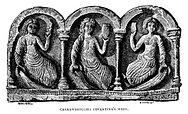This is an old revision of this page, as edited by Nicknack009 (talk | contribs) at 23:05, 5 March 2007 (←Undid revision 112923538 by Manopingo (talk) revert vandalism again). The present address (URL) is a permanent link to this revision, which may differ significantly from the current revision.
Revision as of 23:05, 5 March 2007 by Nicknack009 (talk | contribs) (←Undid revision 112923538 by Manopingo (talk) revert vandalism again)(diff) ← Previous revision | Latest revision (diff) | Newer revision → (diff)| Part of a series on |
| Celtic mythologies |
|---|
 |
| Gaelic |
| Brythonic |
| Literary works |
| Motifs |
| Festivals |
| Folklore |
Scota, in Scottish mythology and Irish mythology and pseudohistory, was an Egyptian princess to whom the Gaels traced their ancestry, explaining the name Scoti, applied by the Romans to Irish raiders, and later to the Irish invaders of Argyll and Caledonia which became known as Scotland.
According to the early Irish chronicle Lebor Gabála Érenn she was the daughter of an unnamed pharaoh, but see below. She married Nel, son of Fenius Farsaid, a Babylonian who travelled to Scythia after the collapse of the Tower of Babel. Nel was a scholar of languages, and was invited by the pharaoh to Egypt and given Scota's hand in marriage. They had a son, Goídel Glas, the eponymous ancestor of the Gaels, who created the Irish language by combining the best features of the 72 languages then in existence.
Goídel (or his son Sru) was expelled from Egypt shortly after the Exodus of the Israelites by a pharaoh. 17th century Irish chronicler Geoffrey Keating names Intuir. After much travelling his descendants settled in Hispania (or Iberia - modern Spain and Portugal), where Míl Espáine was born, and it was the sons of Míl, Eber Finn and Eremon, who established the Gaelic presence in Ireland.
According to Seumas MacManus in his book The Story of the Irish Race, Scota married Niul, but he was the grandson of Gaodhal Glas. Then another Scota, who was coincidentally also a daughter of an Egyptian Pharaoh, married Miled (or Milesius). This second Scota left Iberia with her eight sons and their families, after Miled died, and headed for Ireland. Many of the sons died en route, due to a storm, and Queen Scota died during the battle between the Milesians and the De Danann.
Sources
- Lebor Gabála Érenn
- Geoffrey Keating, Forus Feasa ar Éirinn
- Seumas MacManus, The Story of the Irish Race (February 1970 The Devin-Adair Company New York)
- Seumas MacManus, The Story of the Irish Race (1990 edition printed by Wings Books)
- Michael O'Clery, Annals of the Kingdom of Ireland (1616-1636 Donegal)
- Aidan Dodson, Monarchs of the Nile (1995)